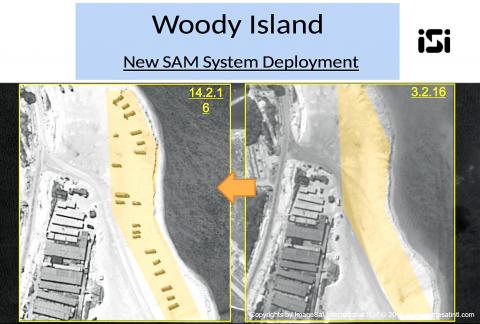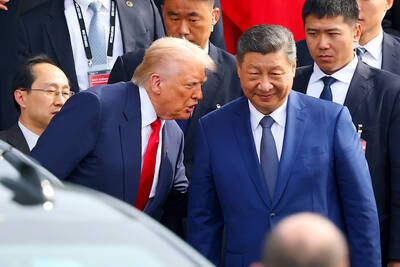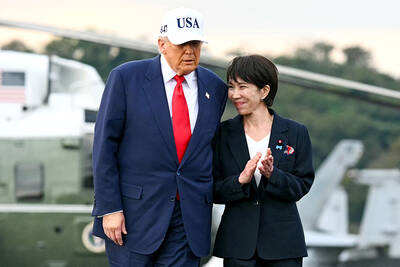China confirmed that it has weapons on a disputed island in the South China Sea, state media said yesterday, as US Secretary of State John Kerry slammed Beijing for “militarization” of the strategically vital region.
The US broadcaster Fox News on Tuesday reported that a privately owned satellite company had provided images that appeared to show two batteries of eight surface-to-air missile launchers and a radar system had been installed on Woody Island (Yongxing Island, 永興島) — one of the Paracel Islands (Xisha Islands, 西沙群島) — earlier this month.
Pentagon officials say the pictures are authentic, and Ministry of National Defense spokesman Major General David Lo (羅紹和) on Wednesday said that Taipei is closely monitoring developments.

Photo: EPA
Taiwan, China and Vietnam claim all or part of the Paracel Islands.
The Chinese Ministry of National Defense yesterday confirmed that “China has deployed weapons on the island for a long time,” reported the Global Times newspaper, which has close ties to the Chinese Communist Party.
It did not specify what weapons were on the island.
However, it attempted to downplay the deployment, saying recent reports were an example of Western media playing “the same old tune” about a “China threat,” the newspaper cited the ministry’s news office as saying.
“China has the fair and legal right to deploy defense facilities within the boundaries of its own territory,” the report added.
Tensions in the sea — through which one-third of the world’s oil passes — have mounted in recent months since China transformed contested reefs in the Spratly Islands (Nansha Islands, 南沙群島) further south into artificial islands capable of supporting military facilities.
Washington says Beijing’s actions threaten free passage in a strategically vital area and has sent warships close to the disputed islands to assert freedom of navigation, raising fears of escalation.
The US is planning “very serious conversations” with China about the anti-aircraft missiles Beijing is believed to have deployed on the island, Kerry said on Wednesday.
Answering questions from reporters in Washington, Kerry said there was “every evidence” that China was increasing militarization in the South China Sea.
He said that Chinese President Xi Jinping (習近平) stood in the Rose Garden of the White House last year and promised that there would be no militarization of the South China Sea.
“We have said repeatedly with respect to China that the standard that should be applied to all countries with respect to the South China Sea is no militarization,” Kerry said.
“We had these conversations with the Chinese and I’m confident that over the next days, we will have further very serious conversations on this,” Kerry said.
The top US diplomat expressed hope that Beijing would work to resolve the maritime disputes “not through unilateral action, not through force, not through militarization, but through diplomacy and by working with other countries and claimants.”
Meanwhile, Beijing has insisted it has the right to build “self-defense” systems in the region.
An editorial published yesterday in the Global Times said that the US has “injected the most military elements in the region.”
If China has in fact placed surface-to-air missiles on the island, they might make “jet fighters from the US ... feel uneasy when making provocative flights in the region. To us, that’s a proper result,” the editorial said.

UKRAINE, NVIDIA: The US leader said the subject of Russia’s war had come up ‘very strongly,’ while Jenson Huang was hoping that the conversation was good Chinese President Xi Jinping (習近平) and US President Donald Trump had differing takes following their meeting in Busan, South Korea, yesterday. Xi said that the two sides should complete follow-up work as soon as possible to deliver tangible results that would provide “peace of mind” to China, the US and the rest of the world, while Trump hailed the “great success” of the talks. The two discussed trade, including a deal to reduce tariffs slapped on China for its role in the fentanyl trade, as well as cooperation in ending the war in Ukraine, among other issues, but they did not mention

Japanese Prime Minister Sanae Takaichi yesterday lavished US President Donald Trump with praise and vows of a “golden age” of ties on his visit to Tokyo, before inking a deal with Washington aimed at securing critical minerals. Takaichi — Japan’s first female prime minister — pulled out all the stops for Trump in her opening test on the international stage and even announced that she would nominate him for a Nobel Peace Prize, the White House said. Trump has become increasingly focused on the Nobel since his return to power in January and claims to have ended several conflicts around the world,

GLOBAL PROJECT: Underseas cables ‘are the nervous system of democratic connectivity,’ which is under stress, Member of the European Parliament Rihards Kols said The government yesterday launched an initiative to promote global cooperation on improved security of undersea cables, following reported disruptions of such cables near Taiwan and around the world. The Management Initiative on International Undersea Cables aims to “bring together stakeholders, align standards, promote best practices and turn shared concerns into beneficial cooperation,” Minister of Foreign Affairs Lin Chia-lung (林佳龍) said at a seminar in Taipei. The project would be known as “RISK,” an acronym for risk mitigation, information sharing, systemic reform and knowledge building, he said at the seminar, titled “Taiwan-Europe Subsea Cable Security Cooperation Forum.” Taiwan sits at a vital junction on

LONG-HELD POSITION: Washington has repeatedly and clearly reiterated its support for Taiwan and its long-term policy, the Ministry of Foreign Affairs said US Secretary of State Marco Rubio yesterday said that Taiwan should not be concerned about being used as a bargaining chip in the ongoing US-China trade talks. “I don’t think you’re going to see some trade deal where, if what people are worried about is, we’re going to get some trade deal or we’re going to get favorable treatment on trade in exchange for walking away from Taiwan,” Rubio told reporters aboard his airplane traveling between Israel and Qatar en route to Asia. “No one is contemplating that,” Reuters quoted Rubio as saying. A US Treasury spokesman yesterday told reporters